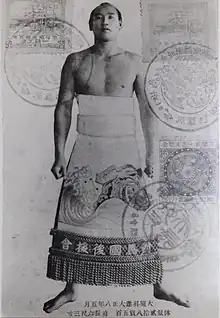Tsushimanada Yakichi
Tsushimanada Yakichi (Japanese: 對馬洋 弥吉, born Yakichi Kawakami (弥吉 川上), August 19, 1887 – February 16, 1933) was a Japanese professional sumo wrestler from Tsushima in the Nagasaki Prefecture.[1] As of May 1962, he is one of six wrestlers in that prefecture to have reached or surpassed the rank of ōzeki,[2] and the first to have achieved this feat since the fourth Tamagaki Gakunosuke, 107 years earlier.[3]
| Tsushimanada Yakichi | |
|---|---|
| 對馬洋 弥吉 | |
 Tsushimanada in a 1919 postcard commemorating his promotion to Ōzeki | |
| Personal information | |
| Born | Yakichi Kawakami August 19, 1887 Tsushima, Nagasaki Prefecture |
| Died | February 16, 1933 (aged 45) Tsushima Island, Japan |
| Height | 1.90 m (6 ft 3 in) |
| Weight | 105 kg (231 lb; 16.5 st) |
| Career | |
| Stable | Dewanoumi |
| Debut | January 1910 |
| Highest rank | Ōzeki (May 1919) |
| Retired | May 1922 |
| Championships | 1 (Sandanme) 1 (Jonokuchi) |
| * Up to date as of October 6, 2022. | |
History
Yakichi Kawakami enlisted in the Tsushima Fortress Artillery Battalion, at the age of 20, for military service. However, the division commander at the time recommended that he become a sumo wrestler because of his good physique, so he was discharged and joined the Dewanoumi stable in 1908.[4] Yakichi chose Tsushimanada as his ring name, or shikona, to pay homage to his home island. In his stable, he became the protege of yokozuna Hitachiyama. His first tournament was delayed until 1910 as he suffered from thiamine deficiency. At the age of 25, he was promoted from makushita to jūryō. In 1915, he entered the top division, where he was the tallest wrestler at the time. During his makuuchi years, he disclocated his shoulder after a bout against yokozuna Ōtori. He was however promoted to ōzeki the following tournament, at the age of 31. At the time of his promotion, a banquet was held at the invitation of Nakarai Tōsui, a famous writer from Tsushima.[4] Tsushimanada, however, did not kept his rank after he injured his left arm during training. He retired in 1922, at the age of 34, and did not remained in his stable as an elder.
Upon coming back to Tsushima, he became the mayor of his village.[5]
In 2017, Sakaigawa stable wrestler Masamitsu Umeno, whose family is from Tsushima, was given the Tsushimanada shikona, or ring name, because he comes from a family originally from the island of Tsushima, and being himself from Nagasaki Prefecture.[6]
In 2018, his 1919's keshō-mawashi was retrieved in the Nagasaki Prefectural Tsushima High School as part of the city's survey of cultural assets. The keshō-mawashi was decorated with light blue waves and golden rocky mountains, portraying a classical Tsushima landscape. The lining is decorated with red brocade such as dragons and phoenixes.[5]
Top Division Record
| - | Spring | Summer | ||||
|---|---|---|---|---|---|---|
| 1910 | (Maezumo) | West Jonokuchi #22 5–0 Champion |
||||
| 1911 | Unknown | Unknown | ||||
| 1912 | West Sandanme #6 5–0 Champion |
Unknown | ||||
| 1913 | Unknown | East Jūryō #3 5–2 1d |
||||
| 1914 | West Maegashira #14 1–6 3h | West Jūryō #1 4–1 1h |
||||
| 1915 | East Maegashira #15 8–2 | East Maegashira #1 5–3 2d |
||||
| 1916 | East Sekiwake #1 6–3–1 | East Sekiwake #1 5–3 2h |
||||
| 1917 | West Haridashi Sekiwake 0–2–8 | West Maegashira #3 5–4 1h |
||||
| 1918 | East Maegashira #1 5–2–3 | East Komusubi #1 6–2 2h |
||||
| 1919 | East Haridashi Sekiwake 6–1 3h | East Ōzeki #1 6–4 |
||||
| 1920 | East Ōzeki #1 4–6 | West Sekiwake #1 0–0–10 |
||||
| 1921 | West Komusubi #1 4–6 | East Maegashira #5 1–2–7 |
||||
| 1922 | East Maegashira #9 0–0–10 | West Maegashira #14 Retired 0–0–10 |
||||
| Record given as win-loss-absent Top Division Champion Top Division Runner-up Retired Lower Divisions Key:d=Draw(s) (引分); h=Hold(s) (預り) | ||||||
References
- "Tsushimanada Yakichi Rikishi Information". Sumo Reference. Retrieved 2022-10-06.
- Along with Tamagaki III, Tamagaki IV, Itsutsushima and Sadanoyama
- "Wrestlers from Nagasaki Prefecture by rank". SumoDB. Retrieved 13 August 2023.
- "対馬初!大相撲の大関に昇りつめた男 - 對馬洋 弥吉 (1887 - 1933)" (PDF) (in Japanese). Tsushima city bulletin. 4 November 2011. Retrieved 28 February 2023.
- "対馬出身力士の化粧まわし見つかる 大正時代の大関「對馬洋(つしまなだ)」" (in Japanese). Nagasaki Shimbun. 2018-01-21. Retrieved 2022-10-06.
- "対馬洋、新十両に喜び「結果だけドキドキしながら待っていました」ケガ乗り越え昇進、師匠に感謝". Nikkan Sports (in Japanese). 28 September 2022. Retrieved 6 October 2022.